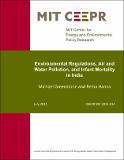| dc.contributor.author | Greenstone, Michael | |
| dc.contributor.author | Hanna, Rema | |
| dc.date.accessioned | 2011-10-17T16:24:27Z | |
| dc.date.available | 2011-10-17T16:24:27Z | |
| dc.date.issued | 2011-07 | |
| dc.identifier.other | 2011-014 | |
| dc.identifier.uri | http://hdl.handle.net/1721.1/66288 | |
| dc.description.abstract | Using the most comprehensive data file ever compiled on air pollution, water pollution, environmental regulations, and infant mortality from a developing country, the paper examines the effectiveness of India’s environmental regulations. The air pollution regulations were effective at reducing ambient concentrations of particulate matter, sulfur dioxide, and nitrogen dioxide. The most successful air pollution regulation is associated with a modest and statistically insignificant decline in infant mortality. However, the water pollution regulations had no observable effect. Overall, these results contradict the conventional wisdom that environmental quality is a deterministic function of income and underscore the role of institutions and politics. | en_US |
| dc.description.sponsorship | MIT Energy Initiative | en_US |
| dc.language.iso | en_US | en_US |
| dc.publisher | MIT Center for Energy and Environmental Policy Research | en_US |
| dc.relation.ispartofseries | MIT-CEEPR;2011-014 | |
| dc.rights | An error occurred on the license name. | en |
| dc.rights.uri | An error occurred getting the license - uri. | en |
| dc.title | Environmental Regulations, Air and Water Pollution, and Infant Mortality in India | en_US |
| dc.type | Working Paper | en_US |
